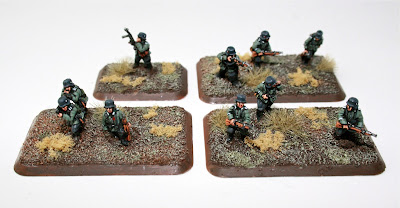The first Zug is finished.
15mm "Blitzkrieg" minis from Skytrex.
As everyone is talking Waterloo these days, I thought I’d use this, my 100th by the way, blog post to highlight another, perhaps less known, anniversary in military history. At 3:15 am on Monday the 22nd June its exactly 74 years since the greatest land battle of all times started – the Nazi invasion of Communist Russia, codenamed “Operation Barbarossa”.
Operation Barbarossa, with its three main thrusts
consisting of Army Groups North, Center and South)
It marked the end of the so-called “Molotov-Ribbentrop Pact” of Non-Aggression, signed in 1939, and would prove the beginning of the end for Nazi rule in Germany. It would have a fatal outcome for hundred thousands of soldiers and civilians, and it would be the stage on which some of histories most gruesome war crimes were committed.
The six man rifle team - according to the Chain of Command rules.
Casualties will be removed with markers, and full bases when possible.
With the aim of building a 15mm collection for the period of Barbarossa (41-42), I was first of all looking for suitable German Blitzkrieg infantry miniatures. While many producers out there offer good products for the Early War period, I decided to go with Skytrex for the infantry. They really are wonderful sculpts, and I like the weight compared to plastic, when I’m basing this small scale.
Cuff insignia for Infanterie-Regiment Großdeutschland.
Tried to add these on the 15mm minis, with varied success.
Next question was what unit to paint up. I wanted a unit that had participated in the initial stages of Barbarossa, but also one, which was later involved in Fall Blau and Wintergewitter. After some advice from co-club members Ulf and Jesper, I decided to go with the Großdeutschland regiment. It’s history really runs deep on the Eastern Front, and it offers versatility of deployment, as it later became upgrade to a panzer reg.
MG34 and Obergefreiter with MP40.
As a further bonus for me, Großdeutschland was part of XLVI Panzer Corps,
of Panzer Group 2 commanded by Heinz Guderian, somewhat a personal favorite among the many capable German army commanders.
of Panzer Group 2 commanded by Heinz Guderian, somewhat a personal favorite among the many capable German army commanders.
Großdeutschland MG gunner.
Großdeutschland have a fascinating history, including dark as well as bright chapters.
My plan is to touch on all aspects, and post for post follow the unit in a chronological way, from the kick off of Barbarossa on the 22nd June 41, until the last remains staggered up towards the Danish border to surrender to the much preferred Brits in 45.
Großdeutschland trooper having a pensive moment at the Eastern Front.
It will be a dramatic journey, including war crimes, near annihilation and heroic counter charges. In other words; to be continued.
Thank you very much for reading!






















